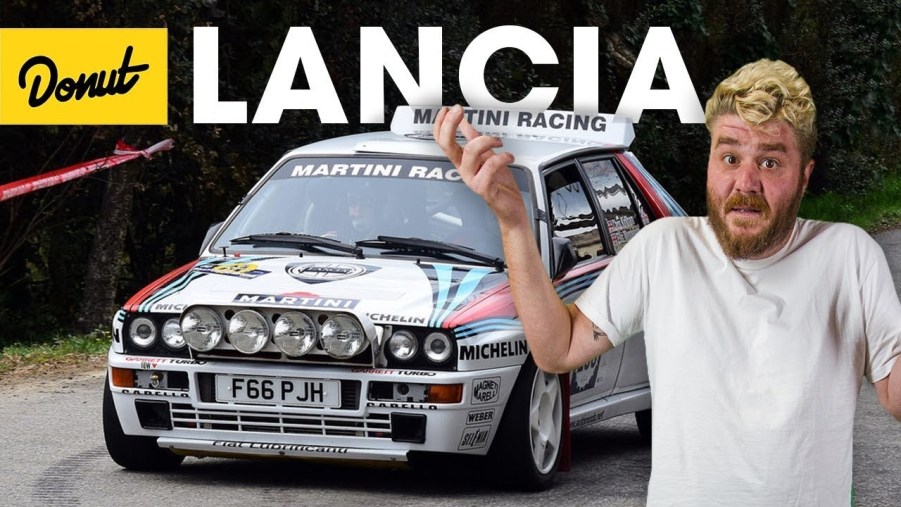
Lancia: One of the Most Successful Off-Road Racing Brands You’ve Never Heard Of
Racing doesn’t just improve vehicles; it also helps automakers start fanbases. Mitsubishi, Nissan, Porsche, and Audi made names for themselves on the rally circuit. And often the technology being flung about on gravel tracks or through desert sands ended up on sale in the showroom. The Audi Ur-Quattro, in particular, helped usher in the modern AWD SUV. But there’s one brand that’s arguably had a bigger impact on the automotive world. Not just on SUVs or trucks, but on almost every vehicle on the road today. It’s an Italian automaker called Lancia, and you’ve most likely never heard of it.
Modern vehicles have a lot to thank Lancia for
Lancia was founded by two Fiat racing drivers, Vincenzo Lancia and his friend Claudio Fogolin, in 1906. Vincenzo’s goal, as Donut Media explains, was for Lancia (the company) to work on new automotive ideas, cost be damned. And soon, that was exactly what the automaker was doing.
As reported by Top Gear, here is a brief summary of the automotive “firsts” that Lancia is responsible for. The company was the first to offer a standard complete electrical system; first to offer a 5-speed transmission and the first with a production V6. The 1950 Lancia Aurelia’s rear transaxle was later used by Ferrari and Porsche, and it had in-board disc brakes like the later Hummer H1 and Toyota Mega Cruiser.
Even more importantly for the modern SUV and car, Lancia was the first automaker to offer independent suspension and a monocoque, aka ‘unibody’, design. Unless you’re driving something like a Toyota 4Runner or Jeep Wrangler, you’re driving a monocoque vehicle.
Lancia was also the first manufacturer to offer a production engine that was both turbocharged and supercharged. This is called twin-charging, and as Engineering Explained and Road & Track explain, this lets an engine make lots of power efficiently without lag. It’s the best of both worlds, and it’s only recently been reintroduced in normal vehicles by VW and Volvo, according to Car Throttle. Lancia was only able to introduce this technology to the masses because it wanted to continue winning rally races.
And it was in rallying that Lancia really showed what it was capable of.
Lancia made history with its rally cars
By the early ‘70s, Lancia had already won the World Rally Championship once, with its Fulvia HF, according to Hagerty. But the company wanted to keep winning; design firm Bertone wanted Lancia’s business, and so designed the HF Stratos Zero concept. It was so low it could drive underneath barrier arms.
This eventually became the mid-engined 1971 Lancia Stratos HF, and because Fiat owned Lancia by then, it was powered by a Ferrari V6. This was the first time an automaker had designed a car specifically for rallying, instead of just modifying an existing design. The Lancia Stratos won 3 WRC titles in a row, 1974-1976.
With Group B starting up, and Audi beginning its Quattro program, Lancia stepped up its game, as Hagerty explained. It managed to win at WRC in 1983 with the 037, the last RWD car to do so. But AWD proved superior, which meant Lancia had to adapt.
Lancia’s rallying Deltas
Using the basic design of its Delta hatchback, engineers created the twin-charged, composite-bodied, mid-engined Delta S4. But due to the rising death toll, Group B ended before the S4 was really competitive.
But Lancia took the S4’s AWD system and modified the road-going Delta into the Delta Integrale. With a more powerful turbocharged engine, off-road suspension, and bigger wheels and tires, the Delta Integrale would go on to be one of the most successful rally vehicles ever. If you’re a fan of the Subaru WRX and Mitsubishi Lancer Evo, you need to thank the Delta Integrale.
Lancia won the WRC title 6 years in a row with the Delta Integrale. And all they did over that period, according to Automobile Magazine, was essentially just add more power, give it more suspension travel, and wider tires. The final version, the Delta Integrale Evoluzione, was so popular and influential, Italians still call it ‘La Regina’, or ‘Queen’. One company, reported Jalopnik, is even restomodding it.
Why aren’t its vehicles available in the US?
Unfortunately, because Lancia kept making improvements during production, their vehicles were basically hand-made, even after switching to factory manufacturing. As a result, although their cars were excellent, the automaker was constantly on the verge of bankruptcy. Buying bought by Fiat did save the company, but it meant sacrificing somewhat on quality.
Italian vehicles have a reputation for unreliability—which is somewhat justified—but Lancia in the 80s and 90s was arguably the worst offender. Their cars, like other Fiats and Alfas of the period, were quick to rust and prone to faults. Lancia’s sales in the US were never strong, but the brand was withdrawn from the States in 1982, same as Fiat.

However, while Fiat eventually returned to the US, Lancia hasn’t. With the company’s reputation sullied in Europe, too, Lancia hasn’t been sold outside of Italy since the mid-90s. At the moment, it makes one car, the Ypsilon, a badge-engineered version of the Fiat 500. And that’s also been discontinued from the US.
Soon, it’s possible all that’ll be left are the memories.
Follow more updates from MotorBiscuit on our Facebook page.


